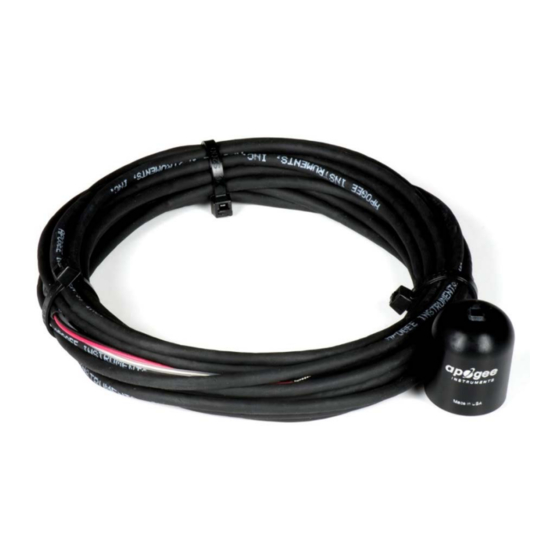
Table of Contents
Advertisement
Quick Links
Advertisement
Table of Contents

Subscribe to Our Youtube Channel
Summary of Contents for Apogee SU-100
-
Page 1: Owner's Manual
OWNER’S MANUAL ULTRAVIOLET SENSOR Model SU-100 (including SS model) APOGEE INSTRUMENTS, INC. | 721 WEST 1800 NORTH, LOGAN, UTAH 84321, USA TEL: (435) 792-4700 | FAX: (435) 787-8268 | WEB: APOGEEINSTRUMENTS.COM Copyright © 2018 Apogee Instruments, Inc. -
Page 2: Table Of Contents
TABLE OF CONTENTS Owner’s Manual ..........................................1 Certificate of Compliance ....................................3 Introduction ..........................................4 Sensor Models ......................................... 5 Specifications ........................................... 6 Deployment and Installation ....................................7 Operation and Measurement ..................................... 9 Maintenance and Recalibration ..................................12 Troubleshooting and Customer Support..............................14 Return and Warranty Policy .................................... -
Page 3: Certificate Of Compliance
(PBB), polybrominated diphenyls (PBDE). Further note that Apogee Instruments does not specifically run any analysis on our raw materials or end products for the presence of these substances, but rely on the information provided to us by our material suppliers. -
Page 4: Introduction
Most UV sensors designed for sunlight measurements are sensitive to UV radiation in the UV-A and UV-B ranges. Apogee Instruments SU-100 UV sensors detect UV radiation from 250 to 400 nm and are calibrated in photon flux units of micromoles per square meter per second (µmol m... -
Page 5: Sensor Models
SENSOR MODELS The SU-100 UV sensor is the only stand-alone UV sensor offered by Apogee Instruments. Additional models are covered in their respective manuals. Model Signal SU-100 Self-powered SU-420 Sensor model number and serial number are located near the pigtail leads on the sensor cable. If you need the manufacturing date of your sensor, please contact Apogee Instruments with the serial number of your sensor. -
Page 6: Specifications
Calibration Traceability Apogee SU-100 UV sensors are calibrated through side-by-side comparison to the mean of four Apogee model SU-100 transfer standard UV sensors under high intensity discharge metal halide lamps. The transfer standard UV sensors are calibrated through side-by-side comparison to an Apogee model PS-200 spectroradiometer under sunlight (clear sky conditions) in Logan, Utah. -
Page 7: Deployment And Installation
Mount the sensor to a solid surface with the nylon mounting screw provided. To accurately measure PPFD incident on a horizontal surface, the sensor must be level. An Apogee Instruments model AL-100 Leveling Plate is recommended to level the sensor when used on a flat surface or being mounted to surfaces such as wood. To facilitate mounting on a mast or pipe, the Apogee Instruments model AL-120 Solar Mounting Bracket with Leveling Plate is recommended. - Page 8 Inline cable connectors are installed 30 cm from the head (pyranometer pictured) Instructions Pins and Wiring Colors: All Apogee connectors have six pins, but not all pins are used for every sensor. There may also be unused wire colors inside the cable. To simplify data logger connection, we remove the unused pigtail lead colors at the data logger end of the cable.
-
Page 9: Operation And Measurement
The sensor is self-powered and applying voltage will damage the sensor. VERY IMPORTANT: Apogee changed all wiring colors of our bare-lead sensors in March 2018 in conjunction with the release of inline cable connectors on some sensors. To ensure proper connection to your data device, please note your serial number or if your sensor has a stainless-steel connector 30 cm from the sensor head then use the appropriate wiring configuration below. - Page 10 3 % of the UV photons are in this range. Because only a small fraction of the photons are in the UV-B range, the SU-100 cannot be used to selectively measure UV-B radiation. The SU-100 is sensitive to UV-B radiation, but it is included with the UV-A radiation to provide a total measurement of UV radiation.
- Page 11 Spectral Errors for UV Radiation Measurements with Apogee SU-100 UV Sensors Radiation Source (Error Calculated Relative to Sun, Clear Sky) Error [%] Sun (Clear Sky) Sun (Cloudy Sky) < 0.5 Reflected from Grass Canopy < 0.5 Reflected from Deciduous Canopy <...
-
Page 12: Maintenance And Recalibration
MAINTENANCE AND RECALIBRATION Moisture or debris on the sensor is a common cause of low readings. The sensor has a domed-shaped housing for improved self-cleaning from rainfall, but materials can accumulate on the photo-sensitive area (e.g., dust during periods of low rainfall, salt deposits from evaporation of sea spray or sprinkler irrigation water) and partially block the optical path. - Page 13 Homepage of the Clear Sky Calculator. Two calculators are available: One for pyranometers (total shortwave radiation) and one for quantum sensors (photosynthetic photon flux density). Clear Sky Calculator for pyranometers. Site data are input in blue cells in middle of page and an estimate of total shortwave radiation is returned on right-hand side of page.
-
Page 14: Troubleshooting And Customer Support
Independent Verification of Functionality Apogee SU-100 sensors are self-powered devices and output a voltage signal proportional to incident UV radiation. A quick and easy check of sensor functionality can be determined using a voltmeter with millivolt resolution. Connect the positive lead of the voltmeter to the white wire from the sensor and the negative lead (or common) to the black wire from the sensor. -
Page 15: Return And Warranty Policy
RETURN AND WARRANTY POLICY RETURN POLICY Apogee Instruments will accept returns within 30 days of purchase as long as the product is in new condition (to be determined by Apogee). Returns are subject to a 10 % restocking fee. WARRANTY POLICY... - Page 16 5. Upon receipt, Apogee Instruments will determine the cause of failure. If the product is found to be defective in terms of operation to the published specifications due to a failure of product materials or craftsmanship, Apogee Instruments will repair or replace the items free of charge.















Need help?
Do you have a question about the SU-100 and is the answer not in the manual?
Questions and answers